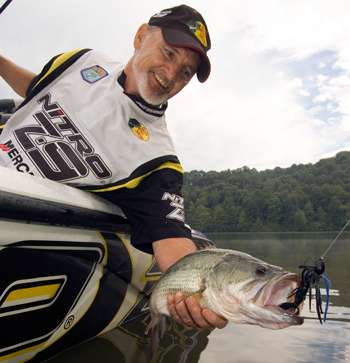
I'm pulling my tackle together for the first Bassmaster Southern Open of 2011 at the Kissimmee Chain in Florida. Since I'm fishing this one as a nonboater, I need to pare my gear down to what I can carry in one trip to my partner's boat. It's a mind-bending challenge.
Once that job is finished, I'll stuff everything in my ancient, beat-up Nissan Altima. It's hanging tough with over 220,000 miles on its odometer. We have much in common.
I'm leaving my Ford F-150 pickup home to cut expenses. That should allow for the gas money I give to my partners. I'll be sharing a motel room with Texan Dave Mansue, who is fishing the tournament as a boater. That'll save a few more bucks.
I'm hoping to get enough work done so I can head south four or five days before the tournament begins. Mansue said I could join him on practice days. I also know several other boaters I could ride with who are also fishing the event.
I could use a few extra days away from Ohio's frigid winter weather to warm my bones in Florida. The forecast here is 8 inches of snow. I also need to loosen my casting arm. I haven't picked up a rod in months.
The weather will play a huge factor during this tournament. It happens at the same time in January that Dean Rojas landed a limit of bass in 2001 that weighed 45 pounds, 2 ounces. This still stands as the heaviest five-fish limit ever at a B.A.S.S. tournament.
The 2001 event was a full-blown bed-fishing extravaganza. Several days of warm weather coaxed the bass to move en masse to their spawning beds the evening before the tournament began. Rojas was one of the few competitors that caught onto this, and he took full advantage of it on the first day of the event.
After that, all the pros targeted spawners. Big bass were so commonplace that 8-pounders didn't raise eyebrows.
I'm all for warm weather, but the last thing I want as a nonboater is an all-out bed fishing tournament. I find no joy in watching my partner sight fish fat, egg-laden, nesting largemouth while I'm stuck in the hinterlands on the back deck.
I'm hoping to draw boaters that are on prespawners. An ideal situation for a backseater would be casting lipless rattling crankbaits to offshore hydrilla. That's how Terry "Big Show" Scroggins won an Open there in March of 2007.
Scroggins fished 22,700-acre West Lake Tohopekaliga, which has lots of hydrilla. However, he caught mainly postspawn bass, which won't be the case in January.
Toho also has abundant native aquatic vegetation thanks to a drawdown done by the Florida Fish & Wildlife Conservation Commission in 2004. The drawdown killed undesirable vegetation and allowed eelgrass, bulrushes, Kissimmee grass, ponds weeds and lily pads to come back.
Fisheries biologist Marty Mann, the project manager for Lake Toho, says that the bass follow a predictable pattern during their prespawn through postspawn cycle. Their first move is to the outside edges of grasslines, such as Kissimmee grass and eelgrass.
As the water warms, the bass move to shallower "intermedial" vegetation, typically to lily pads where they spawn on the pad's root system. Next, they move into a skim of water and spawn near things like arrowhead pads. Then they follow this pattern in reverse.
"We've had a pretty cold winter, which has kept the bass offshore for the most part," Mann says.
A warm spell two weeks prior to the tournament moved some of the bass to outside grasslines, points out Mann. "If it stays warm, they'll move in," he says. "If it gets cold, they'll move back out."
Many anglers will pass through the locks at Toho to gain access to a canal that links other tournament waters farther south, including Lake Cypress, followed by Lake Hatchineha and then Lake Kissimmee.
Bass at 5,500-acre Cypress spawn in Kissimmee grass and bulrushes. When not spawning, they feed offshore in hydrilla and eelgrass.
Hatchineha, with 14,500 acres, has a narrow zone of vegetation around its shoreline. There's plenty of eelgrass here but not much hydrilla.
"For whatever reason, I catch a lot of big bass in Hatchineha on a buzzbait," Mann says.
Kissimmee will draw most of the anglers that lock through. This is because of its large size — 44,000 acres — and the variety of aquatic bass habitat that grows there. You'll find hydrilla in North Cove and Tiger Bay, points out Mann. There is also a wide diversity of Kissimmee grass, bulrushes, lily pads and eelgrass throughout the lake.
Luke Clausen locked through and ran to the southern end of Lake Kissimmee when he won the 2006 Bassmaster Classic. That tournament happened in February, which is normally the peak spawning month. Clausen picked off his bass by casting worms to lily pads.
What does all this mean for me? I had better be prepared for anything. I have no idea which lakes my partners will fish or which baits and patterns they'll be using to catch bass.
Editor's note: Mark Hicks is one of the country's most widely read and respected bass writers. He has penned countless articles for Bassmaster Magazine, B.A.S.S. Times and other publications.

